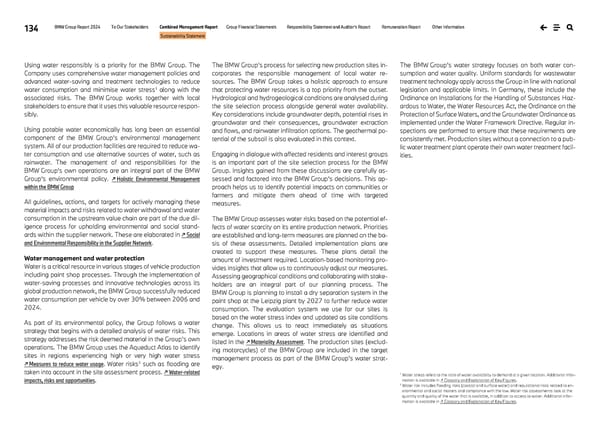134 BMW Group Report 2024 To Our Stakeholders Combined Management Report Group Financial Statements Responsibility Statement and Auditor’s Report Remuneration Report Other Information Sustainability Statement Using water responsibly is a priority for the BMW Group. The Company uses comprehensive water management policies and advanced water-saving and treatment technologies to reduce water consumption and minimise water stress1 along with the associated risks. The BMW Group works together with local stakeholders to ensure that it uses this valuable resource respon- sibly. Using potable water economically has long been an essential component of the BMW Group’s environmental management system. All of our production facilities are required to reduce wa- ter consumption and use alternative sources of water, such as rainwater. The management of and responsibilities for the BMW Group’s own operations are an integral part of the BMW Group’s environmental policy. ↗ Holistic Environmental Management within the BMW Group All guidelines, actions, and targets for actively managing these material impacts and risks related to water withdrawal and water consumption in the upstream value chain are part of the due dil- igence process for upholding environmental and social stand- ards within the supplier network. These are elaborated in ↗ Social and Environmental Responsibility in the Supplier Network. Water management and water protection Water is a critical resource in various stages of vehicle production including paint shop processes. Through the implementation of water-saving processes and innovative technologies across its global production network, the BMW Group successfully reduced water consumption per vehicle by over 30% between 2006 and 2024. As part of its environmental policy, the Group follows a water strategy that begins with a detailed analysis of water risks. This strategy addresses the risk deemed material in the Group’s own operations. The BMW Group uses the Aqueduct Atlas to identify sites in regions experiencing high or very high water stress ↗ Measures to reduce water usage. Water risks2 such as flooding are taken into account in the site assessment process. ↗ Water-related impacts, risks and opportunities. The BMW Group’s process for selecting new production sites in- corporates the responsible management of local water re- sources. The BMW Group takes a holistic approach to ensure that protecting water resources is a top priority from the outset. Hydrological and hydrogeological conditions are analysed during the site selection process alongside general water availability. Key considerations include groundwater depth, potential rises in groundwater and their consequences, groundwater extraction and flows, and rainwater infiltration options. The geothermal po- tential of the subsoil is also evaluated in this context. Engaging in dialogue with affected residents and interest groups is an important part of the site selection process for the BMW Group. Insights gained from these discussions are carefully as- sessed and factored into the BMW Group’s decisions. This ap- proach helps us to identify potential impacts on communities or farmers and mitigate them ahead of time with targeted measures. The BMW Group assesses water risks based on the potential ef- fects of water scarcity on its entire production network. Priorities are established and long-term measures are planned on the ba- sis of these assessments. Detailed implementation plans are created to support these measures. These plans detail the amount of investment required. Location-based monitoring pro- vides insights that allow us to continuously adjust our measures. Assessing geographical conditions and collaborating with stake- holders are an integral part of our planning process. The BMW Group is planning to install a dry separation system in the paint shop at the Leipzig plant by 2027 to further reduce water consumption. The evaluation system we use for our sites is based on the water stress index and updated as site conditions change. This allows us to react immediately as situations emerge. Locations in areas of water stress are identified and listed in the ↗ Materiality Assessment. The production sites (exclud- ing motorcycles) of the BMW Group are included in the target management process as part of the BMW Group’s water strat- egy. The BMW Group’s water strategy focuses on both water con- sumption and water quality. Uniform standards for wastewater treatment technology apply across the Group in line with national legislation and applicable limits. In Germany, these include the Ordinance on Installations for the Handling of Substances Haz- ardous to Water, the Water Resources Act, the Ordinance on the Protection of Surface Waters, and the Groundwater Ordinance as implemented under the Water Framework Directive. Regular in- spections are performed to ensure that these requirements are consistently met. Production sites without a connection to a pub- lic water treatment plant operate their own water treatment facil- ities. 1 Water stress refers to the ratio of water availability to demand at a given location. Additional infor- mation is available in ↗ Glossary and Explanation of Key Figures. 2 Water risk includes flooding risks (coastal and surface water) and reputational risks related to en- vironmental and social matters and compliance with the law. Water risk assessments look at the quantity and quality of the water that is available, in addition to access to water. Additional infor- mation is available in ↗ Glossary and Explanation of Key Figures.
 BMW Group Report 2024 Page 133 Page 135
BMW Group Report 2024 Page 133 Page 135